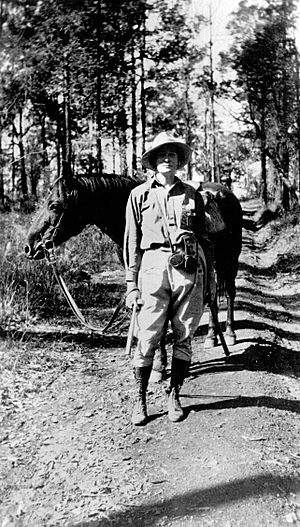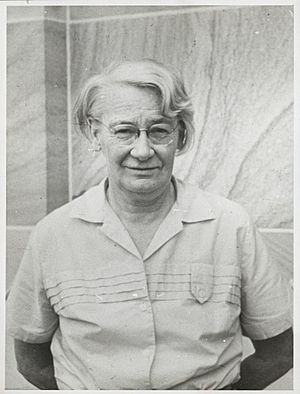Dorothy Hill facts for kids
Quick facts for kids
Dorothy Hill
|
|
|---|---|

Australian geologist and palaeontologist, Dorothy Hill, with horse, Walter (1929)
|
|
| Born | 10 September 1907 Brisbane, Queensland, Australia
|
| Died | 23 April 1997 (aged 89) Brisbane, Australia
|
| Nationality | Australian |
| Education | Coorparoo State School, Brisbane Girls Grammar School |
| Alma mater | University of Queensland, Newnham College, University of Cambridge |
| Awards | W. R. Browne Medal, Clarke Medal, Lyell Medal, CBE, AC |
| Scientific career | |
| Fields | Geology, Palaeontology |
| Institutions | University of Queensland |
| Doctoral advisor | Gertrude Elles |
| Other academic advisors | Henry Caselli Richards |
Meet Dorothy Hill, an amazing Australian scientist! She was a geologist and palaeontologist, which means she studied rocks, fossils, and the Earth's history. Dorothy made history herself by becoming the first female professor at an Australian university. She was also the first woman to lead the Australian Academy of Science.
Contents
Becoming a Scientist: Dorothy's Education
Dorothy Hill was born in Taringa, Australia, on September 10, 1907. She grew up in Coorparoo near Brisbane. She went to Coorparoo State School and then earned a scholarship to attend Brisbane Girls Grammar School. In 1924, she won top awards for her studies in English and History.
Dorothy was also a very active sportswoman. In high school, she loved athletics and netball. At home, she was a skilled horse rider. When she went to the University of Queensland, she played hurdles, ran, and played hockey and rowing. She even played hockey for the University of Queensland, the state of Queensland, and Australian university teams! Later, while studying at Cambridge University, she learned to fly a plane.
After high school, Dorothy wanted to study medicine. However, the University of Queensland didn't offer a medical degree at the time, and her family couldn't afford to send her to another city. Luckily, she won one of the top scholarships to the University of Queensland in 1924. She decided to study science, focusing on chemistry. She also chose geology as an extra subject.
Under the guidance of Professor Henry Caselli Richards, Dorothy graduated in 1928 with top honors in Geology. She continued her research at the university, studying rocks and sediments in the Brisbane Valley. She started collecting fossils after finding ancient corals on a farm in Mundubbera. Professor Richards then helped her get a scholarship to study at the University of Cambridge in England.
At Cambridge, Dorothy worked on her PhD, studying how Australia might have once been covered by an inland sea. She found fossil corals that supported this idea. She stayed in England until 1936, working with other scientists at the Natural History Museum to classify ancient corals. After returning to Australia, she earned a Doctor of Science degree from the University of Queensland in 1942.
Early Career and Coral Research
Dorothy spent seven years in England, publishing important papers about how to describe Rugose corals. When she came back to Australia, she took on a huge project: figuring out the age of Australia's limestone coral fossils. Her work helped map out the Earth's layers across Australia. Her research on corals became the standard for scientists worldwide.
From 1937 to 1942, Dorothy worked as a research fellow at the University of Queensland. She also helped the Geological Survey of Queensland and advised the Shell Corporation. Before World War II, she led geology trips around Moreton Bay and studied the first core samples from the Great Barrier Reef. In 1940, she received the Lyell Fund award for her coral work, a major achievement.
Serving During World War II
During World War II, Dorothy joined the Women's Royal Australian Naval Service. She worked at the Naval Office in Brisbane, helping with secret codes for shipping orders. She worked very long hours, sometimes 80-90 hours a week, while also continuing her coral research. She rose to a leadership position and helped plan how women's services would return to civilian life after the war.
Later Career and Leadership
After the war, Dorothy played a key role in developing the Heron Island Research Station on the Great Barrier Reef. She raised money, arranged for materials to be shipped, and even helped build things like water tanks. Her efforts helped create better labs and housing for visiting scientists.
Dorothy became a full lecturer at the University of Queensland in 1946. She moved up the ranks, becoming a senior lecturer in 1952, chief lecturer in 1956, and a full professor in 1960. This made her the first female professor at an Australian university.
In 1952, she worked with Professor John W. Wells from Cornell University. Together, they wrote important sections on coelenterates (a group of animals including corals) for a major scientific book called Treatise on Invertebrate Paleontology. This book is still updated today. Dorothy also wrote a second volume for the book in 1972.
Dorothy was a leader in many scientific groups. In 1956, she became the first woman to be a fellow of the Australian Academy of Science. She was also the editor of the Journal of the Geological Society of Australia. In 1964, she received the Lyell Medal and became the first Australian woman to be a Fellow of the Royal Society of London, a very prestigious honor.
In 1970, Dorothy became the first female president of the Australian Academy of Science. She also encouraged more girls to study science, trying to inspire parents to support their daughters in scientific fields.
In 1971, Dorothy became the president of the Professorial Board at the University of Queensland, again the first woman to hold this position. She believed that women could be great leaders in universities. She retired from the university in 1972, but continued her research for many years. The university honored her by creating the Dorothy Hill chair in Palaeontology and Stratigraphy.
Dorothy published over 100 research papers and books. In 1978, she finished a huge Bibliography and Index of Australian Paleozoic Coral, a detailed list of ancient Australian corals.
Dorothy strongly believed in the importance of good libraries for universities. She helped develop the University of Queensland's Geology Department Library. Today, the Physical Sciences and Engineering Library at the University of Queensland is named after her. Her thousands of rock samples are kept in the University of Queensland's Geology Museum and other museums worldwide. Several ancient coral species are also named after her, like Acanthastrea hillae.
Dorothy Hill passed away in 1997.
Awards and Honors
Dorothy Hill received many awards for her important work:
- 1934: Daniel Pidgeon Fund, Geological Society of London
- 1940: Lyell Geological Fund award
- 1956: First female Fellow of the Australian Academy of Science
- 1965: First Australian female Fellow of the Royal Society (of London)
- 1966: Clarke Medal by the Royal Society of New South Wales
- 1967: Mueller Medal from the Australian and New Zealand Association for the Advancement of Science (ANZAAS)
- 1970: First female President of the Australian Academy of Science
- 1971: Commander of the Order of the British Empire (CBE) for her services to geology and palaeontology
- 1972: Queenslander of the Year
- 1974: Honorary Doctorate of Laws from the University of Queensland
- 1981: W.R. Browne Medal
- 1993: Companion of the Order of Australia (AC) from the Australian government
Dorothy Hill's Legacy
Dorothy Hill made huge contributions to understanding Earth science in Australia. She was also a fantastic role model, opening up new opportunities for women in education and science. She guided many students who went on to become successful scientists themselves.
The Great Court at the University of Queensland features a stone carving of her face. There is also a statue of her at Brisbane Girls Grammar School. In 2015, Coorparoo State School named a part of their school after her.
In 1997, the University of Queensland's Physical Sciences and Engineering Library was named the Dorothy Hill Physical Sciences and Engineering Library in her honor. In 2014, the School of Earth Sciences at the University of Queensland named their research boat, RV D Hill, after her.
Since 2002, the Australian Academy of Science has given out the Dorothy Hill Award to female researchers in Earth sciences. The Queensland Division of the Geological Society of Australia also awards a Dorothy Hill Medal to people who have greatly helped our understanding of Queensland's geology.
In 2016, scientists found Dorothy Hill's old rock hammer and created a 3D model of it for an exhibition celebrating her life. The electoral district of Hill in Queensland was named after her in 2017 because of her work for the Great Barrier Reef.
The University of Queensland's School of Earth and Environmental Sciences hosts a special event called the Dorothy Hill Women in Earth Sciences Symposium every two years. A street in the village built for the 2018 Gold Coast Commonwealth Games was also named in her honor.
An astronomical observatory at the Brisbane Girls Grammar School's outdoor campus is being named for Dorothy Hill. On September 10, 2018, Google honored her with a special Google Doodle on what would have been her 111th birthday.
See also
 In Spanish: Dorothy Hill para niños
In Spanish: Dorothy Hill para niños


